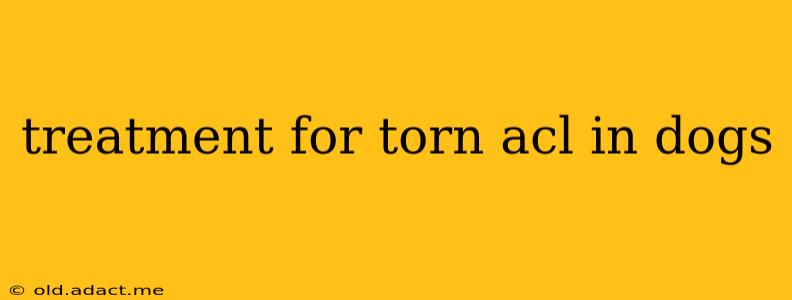A torn anterior cruciate ligament (ACL), also known as a cranial cruciate ligament (CCL) rupture in dogs, is a common and often debilitating injury. This condition affects a dog's stifle joint (knee), leading to pain, instability, and lameness. Understanding the various treatment options available is crucial for ensuring your canine companion receives the best possible care. This guide delves into the specifics of ACL tears in dogs, exploring conservative and surgical approaches.
What are the Signs of a Torn ACL in Dogs?
Before discussing treatment, let's first identify the telltale signs of a torn ACL. These can vary in severity, depending on the extent of the tear:
- Sudden lameness: Often the most noticeable symptom, this occurs immediately after an injury or gradually over time.
- Swelling: The stifle joint may become swollen and warm to the touch.
- Pain: Dogs with a torn ACL exhibit pain when their leg is touched or moved.
- Stiffness: Difficulty extending or flexing the leg.
- Clicking or popping sound: You might hear a clicking sound in the knee joint when your dog moves.
- Muscle atrophy: Over time, the muscles around the affected leg may waste away due to disuse.
What are the Treatment Options for a Torn ACL in Dogs?
Treatment for a torn ACL in dogs varies depending on factors such as the dog's age, breed, activity level, the severity of the tear, and the owner's financial resources. The two primary treatment avenues are conservative management and surgery.
Conservative Management (Non-Surgical Treatment)
This approach focuses on managing pain and inflammation, promoting healing, and allowing the joint to gradually stabilize. It's typically suitable for smaller dogs, older dogs, or those with certain underlying health conditions that make surgery high-risk. Conservative management may include:
- Rest and confinement: Restricting activity to allow the ligament to heal naturally.
- Pain management: Administering non-steroidal anti-inflammatory drugs (NSAIDs) to reduce pain and inflammation. Always consult your veterinarian before giving your dog any medication.
- Physical therapy: Exercises and therapies to strengthen the muscles surrounding the knee and improve joint stability. This often involves a tailored program of range-of-motion exercises and other rehabilitative techniques.
- Weight management: Maintaining a healthy weight reduces stress on the affected joint.
- Supplements: Certain supplements, such as glucosamine and chondroitin, may help support joint health.
Surgical Treatment
Surgical intervention is generally recommended for larger and more active dogs, especially those experiencing significant lameness and instability. Several surgical techniques exist, each with its own advantages and disadvantages:
- Tibial Plateau Leveling Osteotomy (TPLO): This procedure changes the angle of the tibia (shinbone) to reduce stress on the knee joint. It's considered a gold standard for ACL repair, offering excellent long-term results.
- Tibial Tuberosity Advancement (TTA): This method involves moving the tibial tuberosity forward to stabilize the knee. It's another popular surgical choice, offering comparable results to TPLO.
- Extracapsular repair: This technique involves using sutures or other implants to stabilize the knee joint externally. While less invasive than TPLO or TTA, it’s generally considered less effective in the long run and may not be suitable for all dogs.
What is the Recovery Time After ACL Surgery in Dogs?
Recovery time after ACL surgery varies depending on the surgical technique used and the individual dog's response to treatment. It typically involves a period of strict confinement followed by a gradual return to activity. Physical therapy plays a vital role in the rehabilitation process, helping to restore muscle strength and joint function. Your veterinarian will provide specific instructions on postoperative care and activity restrictions. Complete recovery can take several months.
How Much Does ACL Surgery Cost for Dogs?
The cost of ACL surgery for dogs can vary significantly depending on factors such as the surgical technique employed, the veterinarian's fees, and the location. It's essential to discuss the cost upfront with your veterinarian to ensure you are prepared for the expenses associated with surgery and postoperative care.
Can a Dog Recover from a Torn ACL Without Surgery?
While some dogs can recover from a torn ACL without surgery, particularly smaller, less active breeds, it's crucial to understand that this approach may not always be successful and can lead to chronic pain and arthritis in the affected knee. Your veterinarian will carefully assess your dog's specific situation to determine the best course of action.
What is the Long-Term Outlook for Dogs with Torn ACLs?
With appropriate treatment, most dogs with torn ACLs can achieve a good quality of life. The long-term outlook depends on various factors, including the dog's age, breed, size, activity level, and the effectiveness of the chosen treatment. Regular veterinary checkups and ongoing management, such as physical therapy and weight control, are crucial for maintaining joint health and preventing further complications.
This information is for general knowledge and does not substitute professional veterinary advice. Always consult your veterinarian for diagnosis and treatment of your dog's condition.
